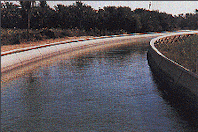|
|
Introduction
 |
Saudi Arabia has built a network of irrigation canals
. |
The Kingdom of Saudi Arabia has made great progress over the past two decades in realizing the long-held objective of achieving self-sufficiency in food production. Saudi Arabia's agricultural development is now considered one of the major accomplishments of modern agriculture in the Middle East. The country's leaders have always encouraged the growth of the agricultural sector, not only for its role in food security, but also for its contribution to diversifying the economy away from oil. Today, the agricultural sector employs a significant number of people and utilizes the latest techniques to produce a variety of goods, stocking shelves in stores in Saudi Arabia and exporting excess supplies to countries across the globe. Agriculture's share of the Kingdom's gross domestic product (GDP) climbed from just 1.3 percent in 1970 to more than 6.4 percent in 1993 -- and it continues to grow at a steady pace.
This agricultural success is all the more impressive considering the geography of the Kingdom. Saudi Arabia is a large country without permanent rivers, and less than two percent of its land surface is under cultivation. The Rub Al-Khali (Empty Quarter), the largest sand desert in the world, stretches across the southern part of the Kingdom. Overall, only an average of about four inches of rain falls annually in the country -- one of the lowest rates in the world. At the same time, the Arabian Peninsula has always harbored fertile regions. The farmers of the Asir region in the .southwest have long practiced rainfed agriculture, raisining maize, wheat, barley and an array of vegetables and fruit in their terraced fields. Verdant palm oases, such as Al-Qatif and Al-Hasa in the Eastern Province, have always enlivened the brown of the desert. In Hail and Al-Qasim provinces, long stretches of arable farmland yield grains and vegetables and are dotted today with chicken and dairy farms.
Water, of course, is the key to agriculture in Saudi Arabia. The Kingdom has successfully implemented a multifaceted program to provide the vast supplies of water necessary to achieve the spectacular growth of the agricultural sector. A network of dams has been built to trap and utilize precious seasonal floods. Vast underground water reservoirs have been tapped through deep wells. Desalination plants have been built to produce fresh water from the sea for urban and industrial use, thereby freeing other sources for agriculture. Facilities have also been put into place to treat urban and industrial run-off for agricultural irrigation. These efforts collectively have helped transform vast tracts of the desert into fertile farmland. Land under cultivation has grown from under 400,000 acres in 1976 to more than 8 million acres in 1993 .
|